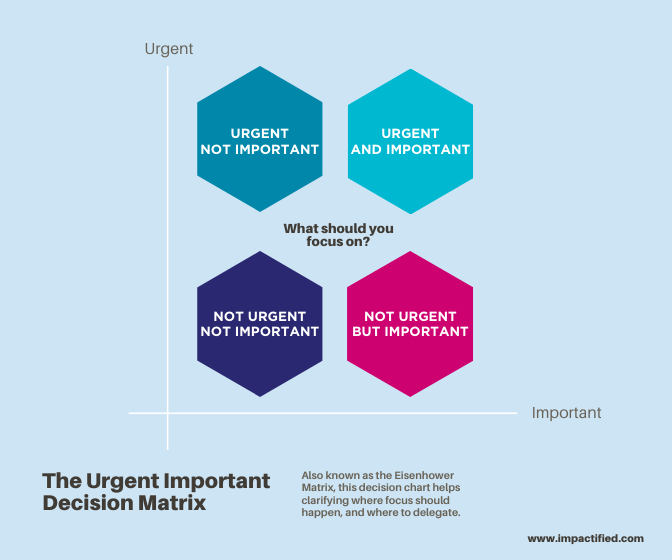The Eisenhower matrix template is always presented as the ultimate time management quadrant. Dwight Eisenhower, the 34th President and Supreme Commander of the United States, allegedly turned it into a real-life decision matrix. He’d rely on it in the morning to align his immediate priorities with his short, medium, and long-term goals, thus filtering the important tasks and activities away from the rest.
As a result, we see it everywhere out there, and it has become a typical productivity hack for entrepreneurs. In fact, a question that people often ask us is the following one: when speaking about the Eisenhower matrix how does one quickly identify the not urgent not important tasks to eliminate them from a to-do list?
That’s a great question because decision-mapping systems are very efficient when it comes to helping people change or improve their way of working, yet there’s a lot more to it than just a time management grid.
Problematically, whilst there’s a lot of articles out there explaining how to use the decision matrix, the conclusion is usually the same: focus your attention and efforts on what’s urgent and important.
Except that this reasoning won’t get you anywhere.
The usual urgent vs important reasoning is wrong.
The usual urgent vs important reasoning is wrong! It will help you cope a little better in the short term, yes. But that’s it.
Wondering why? Well… the typical analysis of the graph is based on the idea that what you want to achieve is productivity. And for most people productivity is a matter of how much you can do in as little time as possible.
But here’s the thing. What if the key was to replace the idea of being productive with the idea that you should be impactful? What if the actual value of the Eisenhower Principle lay in one’s ability to actually think outside the box?
In this article, we’re telling you everything you need to know about the Eisenhower decision matrix (also known as the Eisenhower Box, by the way). And we’re showing you how to use it as impactfully as possible.
Beware, our suggestions will be a little counter-intuitive at first. Once you get our point though, you won’t see things the same way ever again.
[block id=”4660″ title=”Need a boost on computer”]
The urgent important matrix template – in theory.
If you’re reading this page, you already aware of the important vs urgent dilemma and you probably already know the big picture behind the Eisenhower Box. To put things simply, the whole thing is a priority quadrant where one variable represents the important while the other represents the urgent.
When combined, the two factors give our ways to organize the things we do, depending on their degree of urgency, importance, or both.
Of course, the Eisenhower matrix isn’t just a matter of tasking. It really aims at helping you with decision-making in general and should be used as such, whether that’s in your professional or personal life.
The big picture.
Now, here’s a reminder on the big picture. If you look at the graph below, things get pretty clear pretty fast.
Some tasks as non urgent and non important.
Some tasks are urgent but not important.
Some tasks are Important but not urgent.
And the remaining ones are important and urgent.
The question is, what is the best way to interpret and use the urgent important matrix template? Well, as mentioned earlier, this is where things become interesting.
Typical analysis of the urgent important quadrant – ditching or delegating the non-important.
Typically, the Eisenhower matrix template is interpreted by looking at four quadrants.
On the left side of the chart, you would find all the tasks you should forget about because whatever value they create is not considered “important”. Said differently? The Eisenhower method is based on the important side of things – and we’ll get back to that in a moment.
At the bottom, the ones that are not important and not urgent can be ditched without second thoughts. For instance, answering emails that are unsolicited and irrelevant, or the calls and meetings that won’t make any difference whatsoever would typically end-up in that box.
At the top, the second quadrant includes the ones that are urgent but not important can also be left aside. However, they come with a certain degree of emergency so they should probably be delegated to someone else. For instance, returning a call from your accountant can be urgent (because a file needs to be closed), but there may be no fundamental importance for your business.
Overall, the takeaway is easy: ditch or delegate the non-important.
Usual approach: Keep the important non urgent for later.
On the right-hand side of the chart is the pillar of the Eisenhower Box.
That’s where the important urgent matrix really comes into consideration, and that’s where busy people typically turn into highly effective people.
At the bottom comes the important stuff that’s not particularly urgent. For instance, building an analytics dashboard for the website, or building a process to facilitate and automate the management of whatever invoices you keep forgetting on your desk. More significantly, working on a quality control strategy or process would also fit there if it’s not a matter of life or death.
On top is the important that’s also urgent. For instance, that’s paying the internet bills so you don’t get cut off, or managing that quality control issue that’s putting your business in jeopardy if it’s not solved immediately.
There, the typical piece of advice you’ll find everywhere is this one: focus your attention on whatever is both urgent and important. Without that, your business could fall apart, and you can still do the important rest later anyway.
Problem: the difference between urgent and important is… important.
There is a significant problem with this approach, however. By focusing your attention and efforts on the urgent and important stuff, you shoot yourself in the foot. You give priority to the last-minute kind of thinking and acting, at the end of the day, and that puts you in a very negative type of loop.
You got rid of the non-important, that’s right, but you don’t take control!
On the opposite, you remain within a logic based on to-do lists and you keep doing whatever fire control tasks you were trying to get rid of in the first place.
You wanted to save time and become more productive, but you keep reacting to whatever circumstances are thrown at you instead of taking control. It doesn’t make much sense, does it?
Nope, it doesn’t. So, here’s the thing. The difference between urgent and important is super-duper mega important.
Let’s take our previous examples again.
Should you take urgent calls from your accountant and spend a few hours every week for the next six months managing invoices when they can’t wait anymore? Or should you invest some time and effort into building an invoice management process so that your accountant can receive the invoices directly and deal with them efficiently while you focus on something more important?
Clearly, the process-building exercise can wait. Still, should it wait?
Think about it.
How much do you charge for two or three hours of your time? Alternatively, how many clients could you find with an extra three hours per week?
If the second option seems more impactful, wouldn’t it be more efficient to spend a few hours now on building a process so you can skip the paperwork and focus on making money instead?
Schedule management: who is this urgent for?
When working on your time and schedule management, it’s important to define urgency and importance. To do that, you can ask yourself one simple question. Who is this task urgent and important for?
If the task is important and urgent to you, then go for it. In most cases, however, the importance and urgency are on someone else’s side. The accountant needs the document now and applies pressure so he can get his things done. Right?
Decision matrix takeaway: your time is worth a lot more than you realize.
The takeaway is simple here. Your time is worth a lot more than you realize, and your ability to prioritize tasks and actions is the best way to shift from a productivity race type of logic to an impactful decision logic.
Real-life example: when emergency “reactions” create a negative loop.
Truth be told, we see this bias every day in our business coaching activity. Our clients are entrepreneurs and they usually run after time. And people. And money.
On most occasions, however, the reason why they keep running is that they do everything they can to keep reacting to circumstances instead of building important but not urgent processes and systems to save time later.
In one particular case, we were hired by a client who struggled with a retail business. When the client got in touch with us, the big issue was related to quality control. Except that we knew that the problem was related to the way they were making business decisions on a daily basis.
Invoices got mixed-up and orders didn’t follow so the client’s client wasn’t happy with the quality of the product and service.
At the same time, the client was so busy sorting emails and invoices that there was no time left to follow production and keep the end client informed of minor delays. They knew something was wrong on the urgent vs important side of things, but they’d never thought about putting things into a priority matrix template. No wonder why someone was grumpy!
How to increase productivity in business: think twice.
So, the client came to us asking how to increase productivity in business. When we asked them “Is it the best practice to mark every task as Urgent?”, they gave us a clear “no”.
Still, they had no clue about how they could structure their modus operandi, so we insisted on the non urgent important stuff. We made them work on setting processes so that invoices would arrive automatically at one email address, before being sorted automatically into a specific file, managed by one specific person at specific intervals.
Yes, designing the process took time. Still, the trial and error process made them realize that a lot of manipulations could be avoided. After a few months, our client realized that the difference represented a big afternoon of work saved every week.
That time was then re-invested. More processes could be built to help save more time on other matters. And more free time was allocated to strategic thinking and brainstorming ideas (let alone sailing, hiking, and golfing).
Ultimately, they realized that they could either keep reacting to whatever business karma was throwing at them or start acting to stop the nasty fire-controlling routine they were sunk into.
Setting your priorities is important. And urgent.
Overall, if you’re interested in more effective planning and time management, the key is to realize that you should probably reconsider the way you interpret the Eisenhower decision matrix.
Yes, the important and urgent matrix is a reputed time management quadrant system. But its efficiency depends on your own ability to focus, select important factors to be taken into account, and set priorities that make sense.
As an entrepreneur, you will have to manage important and urgent tasks. No doubt about that.
Still, your job is to build systems to ensure that there is less and less urgent stuff to manage. In fact, the biggest important and urgent thing in your business life right now is probably to figure out how to ditch the urgent completely.
Turning the Eisenhower matrix template into practical change.
Don’t stop here. What could be your own typical Eisenhower matrix examples?
Take some paper and draw the Eisenhower box on it. Then try to figure out what you do every day, and how you could place it on the decision matrix.
- How many urgent calls do you take on a weekly basis, with a limited importance in the end?
- How many important messages could you read later?
- Take a moment and think about this: how can you define urgently?
- What are some important but not urgent tasks you have on your to-do list?
- In fact, what is the best way to prioritize a to-do list?
- What are your 5 best anti time-wasting principles?
- Is your planning effective in the end?
- In light of the above, shouldn’t you invest some time in non-urgent but important life-changing processes?
- What alternative options and choices do you have?
- What type of processes could that be?
At the end of the day, the point is that there is no point in trying to cope with whatever BS you struggle with. Time management isn’t about stuffing as many things as possible in your diary, it’s to make your time and efforts impactful. So, how do you plan on doing that?
Looking for effective planning and time management tools?
Before we wrap things up, we wanted to give you a couple of additional entrepreneurs’ hacks.
No joking here, your ability to prioritize actions and tasks is key to becoming more impactful. Setting the right priorities will help plan your time (and the time of others). Perhaps more importantly, it will save you the hassle of adapting to management tools which won’t have any effect unless you approach them with the right mindset.
As to what planning and time management tools you can use, here’s a couple of suggestions.
One, try our time-saving self-coaching module. We’re going through a lot of concepts in it, and these will save you a lot of effort.
[block id=”4682″ title=”Working too much module”]
Two, think about building yourself a roadmap. Roadmaps require setting priorities in the first place so they can get you in the right direction with minimum effort. They can really help you set goals you can measure and milestones you can build on.
Ultimately, having a direction in the medium and long-term will help you set priorities you will then be able to use to define what’s important and what’s urgent right now. They’re a basis when it comes to building your own prioritization matrix, you’d be silly not to use them!
The good news is, our time management module includes tools and templates to do just that, so you really have no excuses!
[block id=”4660″ title=”Need a boost on computer”]
One last thing…
One last thing before we leave. This weighted decision matrix isn’t worth considering just because it’s got the name of a President, or because leading authors like Stephen Covey are talking about it in their books. It’s interesting to include in your own life because it really has the power to make a difference.
If you have a doubt, here is a quick exercise.
- What’s your annual turnover?
- How many hours do you work per day, week, month, and year?
- Divide your annual turnover by the number of hours you work, and you’ll know what value you produce as an entrepreneur.
- Put things in perspective and compare the value you create by sending emails for two hours per day, to the value you create every hour from a turnover perspective.
So, tell us. Is that really worth your time or could you find ways to rethink your priorities? There’s probably a simple decision to be made here!












